This Triumph Bonneville T120 custom is the first custom bike build by Triumph, South Africa (Johannesburg). It took a customer’s T120 Black and transformed it into this super-nimble and assertive roadster – a perfectly adapted machine for a lively urban commute.
Triumph Bonneville T120 Custom Build

Many people during this pandemic, whether inspired by art, film, literature and or individuals, have immersed themselves in new pursuits. Alternatively, (with renewed fervour) delved into existing pursuits.
Within these activities, most have found comfort and diversion, while anticipating the return of a world that (somewhat) resembles its pre-pandemic incarnation.
For (one rider) Racuni Naidoo in Johannesburg, South Africa, that merely meant dusting off the cover of Zen and the Art of Motorcycle Maintenance. Reading it again (after 35 years), then duly commissioning his first custom build – his only two-wheel machine as the base platform.
In turn, it gave a team of technicians the opportunity to undertake their first full (albeit light) custom build together. And in the process of shaping metal and fettling components bore camaraderie.
Bonneville T120 Custom Build

Base Platform
Triumph SA, Johannesburg, was chosen to undertake the build. So, perhaps unsurprisingly, a liquid-cooled, Triumph Bonneville T120 Black (MY18 – registered in 2019) was the chosen base for the build.
Regardless, the Bonneville T120’s classic looks, combined with modern tech and reliability, make it an excellent base from which to start. In the looks department, it’s on 3rd base already and mostly just requires individualisation rather than prettification.
For wrenchers, the British twin is easy to work with and comes with a deep catalogue of parts, meaning that a comparatively unique look can be achieved with relatively little outlay. Or equally, a light custom build can be augmented with Triumph’s existing line of CNC-machined parts. That’s probably why both amateur tinkers and professional bike builders like it.
In the case of Racuni’s bike, the approach was the former. And naturally, the team utilised local expertise to finesse the build. But besides that, it tapped into the global ecosystem of aftermarket custom parts to create its vision.
Straightforward Brief

But… Covid Delays
The build was completed at the end of 2020, around nine months after Racuni and Paul Jacobs (Triumph Johannesburg’s Technical Manager) began discussions. For a comparatively non-technical build, this seems quite a lag – but for that, you can thank the impact of COVID-19.
Nevertheless, the brief was modest and straightforward: 1. Lower the stance and shave off weight, to make the bike more agile for urban commuting. 2. Create a stripped-back look that echoes the aesthetic cues of the 1950s and ’60s cafe racers.

Research and discussions to gauge the feasibility of ideas and aesthetic aspirations followed. And yet, that combined had little effect in setting any plans in stone. As such, the process evolved naturally. But (likely inevitably) into a custom build more substantial than maybe originally conceived.
Experimentation with parts and components was the modus operandi. The final look, a culmination of precisely that. In this case, much to the benefit of this parallel-twin’s looks and manoeuvrability. And indeed the merriment of its owner.
Bonneville T120 Custom: Front End & Suspension

The team commenced the build with gusto, and readily tackled one of the main aspects of the brief – the lowering of the bike’s centre of gravity. To that end, Wilbers Performance Suspension in Germany was selected and then primed.
Sometime thereafter (following a production delay), due to the COVID-19 lockdown, Wilbers built and delivered the custom suspension that appears on the bike.
The front forks and rear shocks were then combined with a set of Pirelli MT60RS, 160/70 and 110/80 tyres (rear [17″] and front [18″] respectively). Instantly, the bike was lowered by 25mm.
And pertinently, without compromising the motorbike’s electronic systems: ABS, TC or ride-by-wire. Additionally, the front and rear shocks were precisely tuned to the rider’s weight.

Bulbous indicators that come as standard with Triumph’s Modern Classic range were supplanted by a discreet set of LED lights. Almost imperceptibly, they’re attached to the headlight bracket. The original front fender was shortened by Paul and painted in a matte black tone that matches the rest of the bike. Along with the CNC front brake reservoir cap and handlebar clamp, it contributes to a decidedly minimalist front end.

A simple but compelling feature arose from the choice to cerakote the cluster rings in satin black. It now offers a cool contrast to the brushed aluminium in which the gauges are housed.

The front-end has been morphed into a far more assertive roadster, with a brat-esque appearance. It’s particularly noticeable when viewing the lowered ignition hub, instrument cluster and grill-covered headlight. The latter is affixed with a blacked-out CNC-machined mount.
Short adjustable levers, bar-end mirrors from Triumph’s catalogue – echo the colour scheme of various components used throughout the build and, in turn, further enhance the minimalist credentials.
Bobbed Rear End

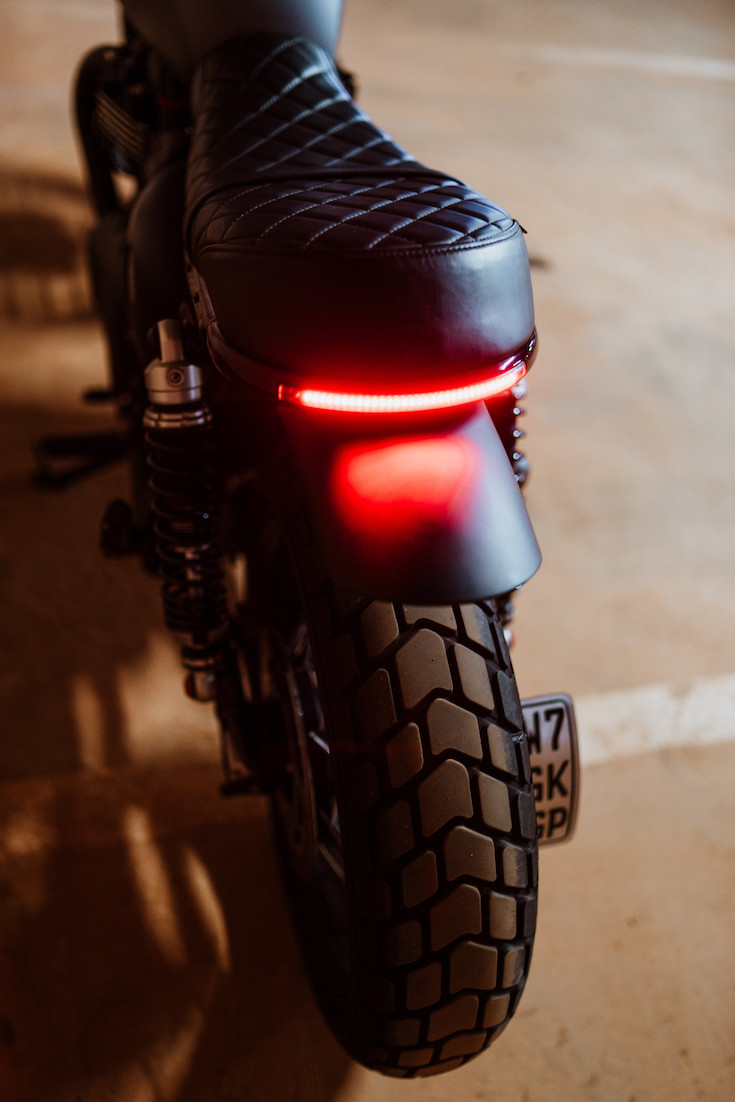


Moving on to the rear, the team were keen to echo the design lines of yesteryear’s cafe racers. And much discussion and deliberation were had on deciding the shape of the rear.
Although what was clear to all was that it would be shortened. And for that, the team ultimately looked towards Cádiz, Spain, specifically towards Macco Motors. It was decided that an off-the-shelf rear-end kit (designed by the custom outfit) should form the basis of the backend.
However, (once again) Covid-19 restrictions and distance conspired together to cause a hefty delay. So, delivery of the kit proved to be far more protracted than anticipated. The package eventually made its way to the workshop, covering many more than the usual 4,800 miles between Johannesburg and Cadiz. Finally, arriving via London and Nairobi.
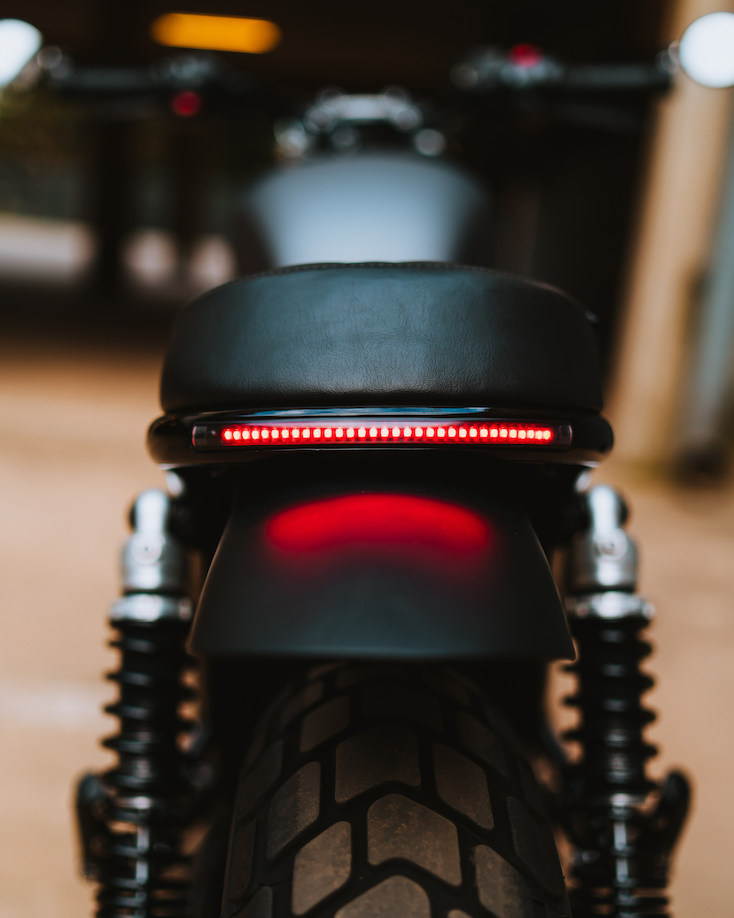

It’s at this point that the build, both literally and figuratively, began to take shape. Immediately, with the help of a local metalworker, the frame was bobbed and hooped. Then a flush-mounted LED taillight was integrated. An up-curved, diamond-stitched, leather seat (in black) and a rear fender (again from Macco Motors, also in black) complete the rear in a stealthy way.
It’s a minification effect that further enhances the sportier poise of the machine.

Additionally, with Paul’s handcrafted meshed, circular-drilled, side covers, the rear also achieves a more rugged finish, albeit in a firmly refined way.

Bonneville T120 Custom Components & Pipes
For the pipes, Bonnie’s standard peashooters were swapped out. Initially, a set of end cans from a Speed Twin was requisitioned and repurposed to great effect (a far deeper exhaust note). Nevertheless, in the pursuit of a leaner machine, in keeping with its urban roadster/racer aesthetic, shorties were sought.

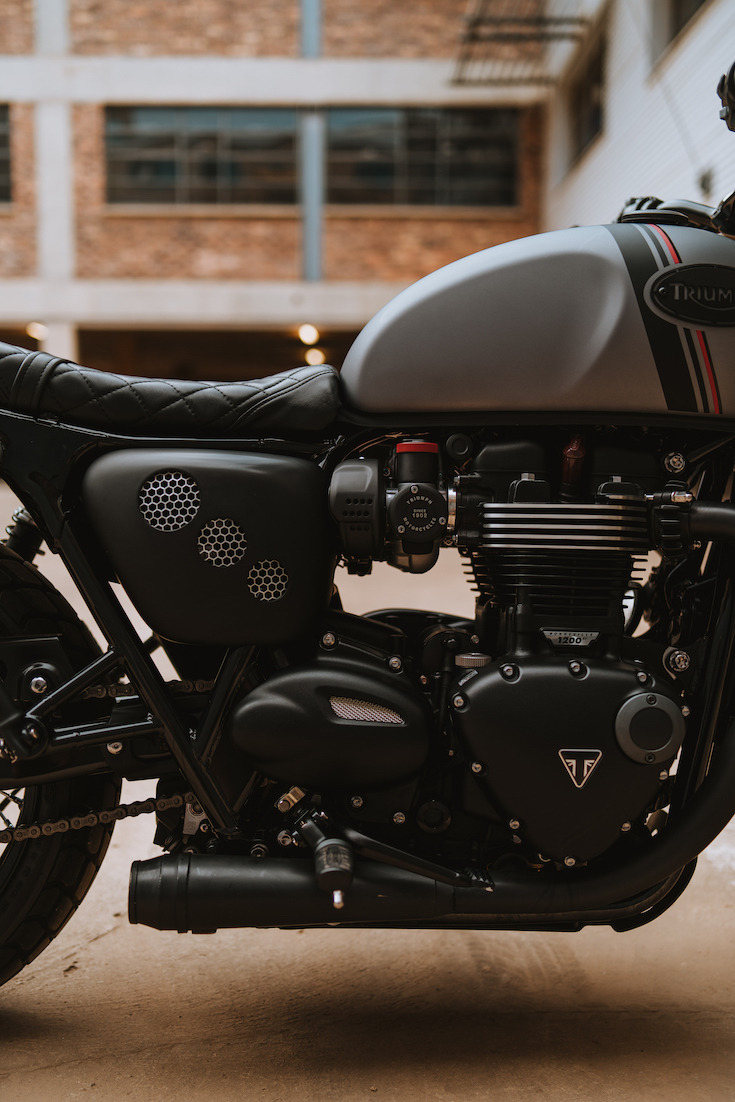
Stealth Performance (an aftermarket exhaust specialist in South Africa) was engaged. And its custom low-slung, short exhaust works incredibly well with the black headers. There isn’t anything superfluous about the short pipes and such bulk is further reduced. As a result, the back third of the bike is decidedly spartan. With its exposed swingarm, it’s super-clean.

Parts and components, for the most part, received a blacked-out, Cerakote finish either in a satin black or graphite. However, the engine components are finished in a slightly more industrial powder coat.
The tank cap, bar-end mirrors, rings on the gauges and levers were also dressed in graphite black, along with a few other small touches.
Overall, after stripping the motorbike and adding the new parts, an outstanding 14 kilograms was shaved off the mass. And with that newfound agility, another criterion, set by the brief, was ticked.
Fuel Tank & Paint

Paintwork is so very often the maker and breaker of custom builds, regardless of ingenuity. So the team took no chances and outsourced the work. Notable paint workshop Kicker Paints was given the task of setting an eye-catching scheme for the build. And paying particular attention to texture as well as colour, it didn’t disappoint.
On the satin grey/silver fuel tank, the outfit opted for a simultaneously moody yet vibrant pinstripe pattern. Kicker used a combination of black gloss and satin stripes to echo the shades used on the frame, components and engine.
It then teamed that with a red stripe, similar in hue to that of the T120’s switches and levers.
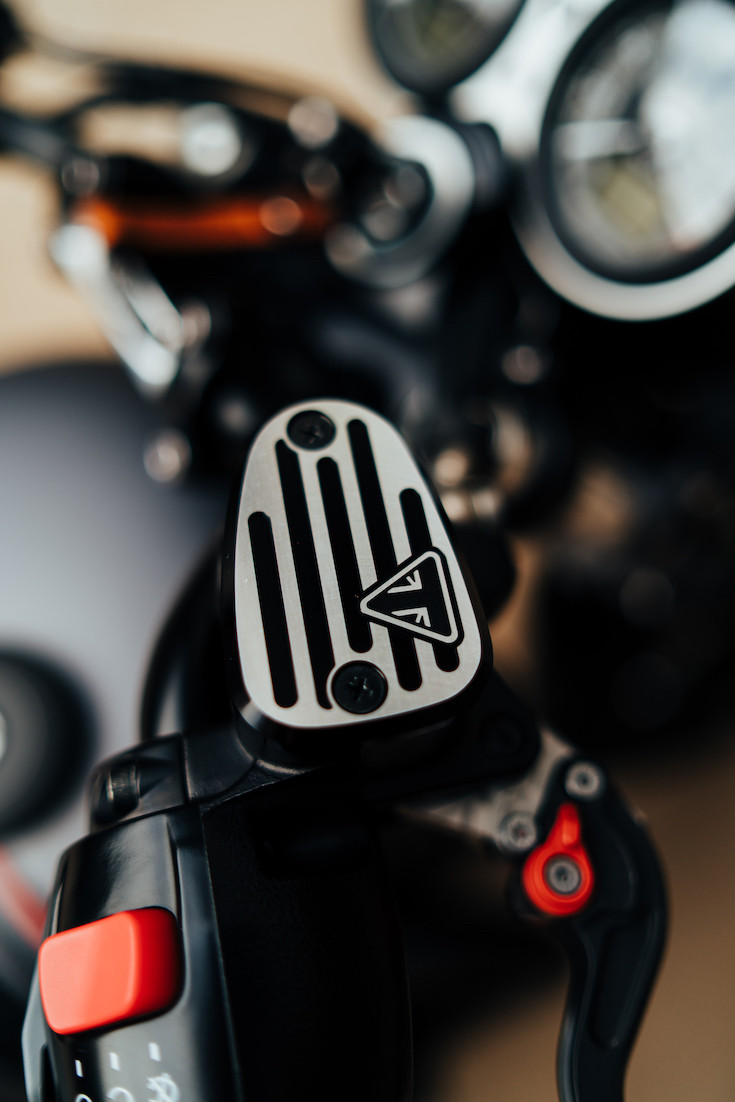

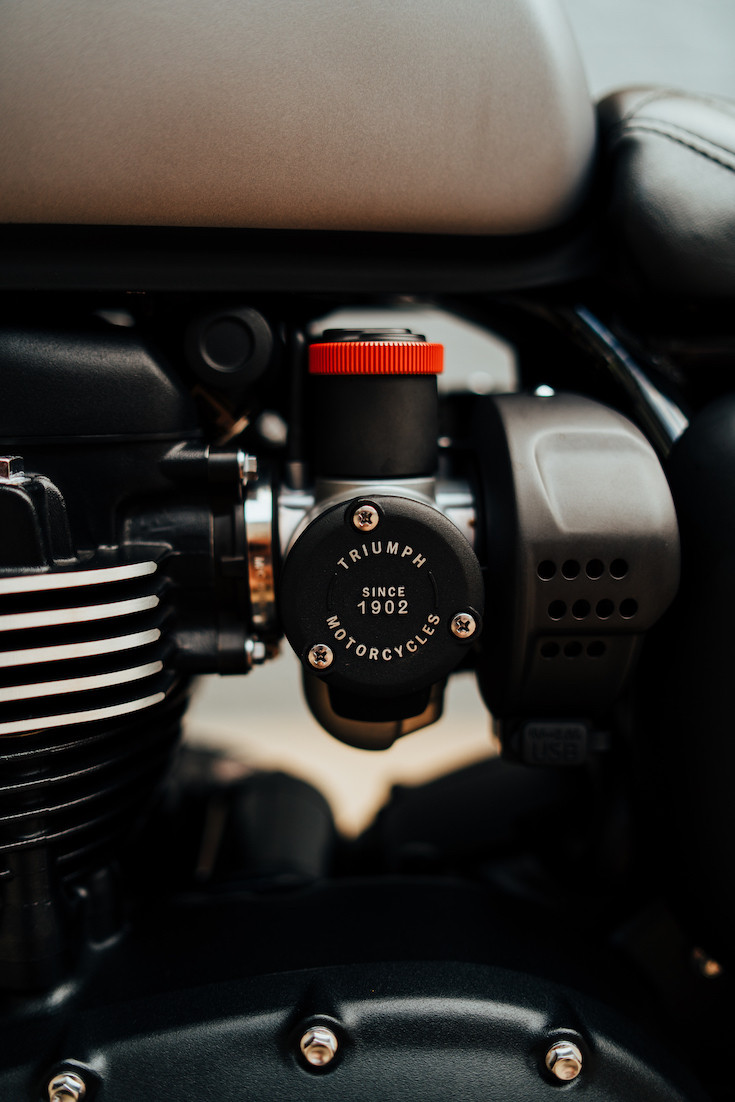
Deftly, this same red is picked up on parts that are ordinarily inconspicuous. Appearing on the rings of the faux carbs (throttle-body) and the lower shock bolts at the rear. It has an impact much greater than its sparing use and captures the eye’s gaze magnificently.
A neat finishing touch to the tank is the (earlier mentioned) cerakote, graphite tank cap, which sits in subtle contrast to its surroundings.
Laser-cut tank badges
A cool and rather quirky touch is the mismatched laser-cut badges on either side of the tank. For those, Paul roped in an engineer friend and Scrambler 1200 XE rider (armed with CAD). The friend had previously created a few similar, neat pieces for the Scrambler 1200 that Paul greatly admired and thought would work well on this build. He wasn’t wrong.
On the right of the fuel tank, Triumph’s traditional logo can be found, finished in a textured black powder coat – similar to the 1200cc power plant. On the left is its more modern counterpart (the triangular emblem), finished in smooth Graphite black – mirroring the other cerakote work.


On reflection, the mixing of the two logos appears perfectly apt. Maybe a metaphor/celebration of the seemingly incongruous nature of a machine, that is both classic and modern.
Reception?
While this build may not be as elaborate as a few customs you may see elsewhere. The work, however, is as conscientious as many and has yielded an impactful outcome. More importantly, it meets the objectives of the customer.

According to Racuni, with the weight saving and altered stance, the bike “… has much-improved agility and manoeuvrability…” and the “… end result surpassed all expectations both functionally and aesthetically.”
More so, with this machine as his daily ride, the complexities and anxieties inherent within modern city living seem to have dissolved into the background.
For the build team and wider Triumph family in Johannesburg, it garnered tangible excitement throughout the process.
Now with a few lessons learned, (particularly around logistics unique to South Africa’s location and sourcing of parts), it’s created a plain thirst for future builds.
A second build is already on the cards. All that seems to be needed is a donor – a Triumph Street Scrambler 900.
Something suggests it won’t be too difficult to source such a bike – and equally that it’ll be a looker – if Paul and Racuni have anything to do with it.

Triumph SA, Bonneville T120 Custom: Parts List in Full
- Wilbers front fork internals set up for rider’s weight
- Wilbers Rear shocks set up to rider’s weight
- Pirelli MT60RS tyres (110/80R18 and 160/60R17)
- CNC headlight mount to lower the headlight
- Repainted headlight bucket
- Headlight grill (Triumph)
- LED indicator front (Motogadget)
- Dropped cluster underneath the upper yoke
- CNC front brake reservoir cap (Triumph)
- CNC handlebar clamp (Triumph)
- Cerakoted Adjustable levers (Triumph)
- Cerakoted Peep bar end mirrors (Triumph)
- Cerakoted Cluster rings
- Custom paintwork on fuel tank (Kicker Paints)
- Custom laser-cut badges on fuel tank (One-off by a friend)
- Cerakoted Fuel cap
- Cerakoted engine badges
- Black Sump guard (Triumph)
- CNC oil filler cap (Triumph)
- Cerakoted throttle-body components
- Painted throttle-body side covers
- USB relocation
- Cerakoted intake covers
- Staggered drilled and meshed side covers
- Drilled chain guard (Triumph)
- Cerakoted rear shock bolts
- Rear frame hoop with a flush-mount tail light (Macco)
- Rear fender on a custom mount (Macco)
- Handmade diamond stitch leather seat (Macco)
- Original front mudguard shortened by Triumph
- Custom low-slung short exhaust (Stealth Performance)
- Cerakoted multiple small items to compliment the colour scheme
Image Credits:
- All still images – Drihan Bester – Instagram: @auto_mensch
- T120 riding through Johannesburg – Richard Harper – Instagram: @ridemotostakephotos






